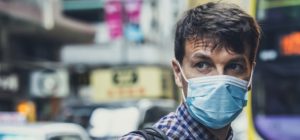Face Masks and the COVID-19 Pandemic
Compiled by Frank Rosenthal for Science for the People
Last updated: April 13, 2020
1. How effective are face masks at preventing the spread of COVID19? What is the comparative efficacy of masks, social distancing, handwashing?
Most sources agree that social distancing, face masks, and handwashing are all important in controlling the spread of COVID-19. It is difficult to do a scientific comparison of the effectiveness of these measures because of variation in how each is applied (e.g. the type of mask, how frequently worn, the frequency of handwashing etc.). In some controlled studies, the effectiveness of wearing a face mask and frequent handwashing have been found to be approximately equivalent. The most prudent approach is to apply all protective measures, including facemask when in the presence of others, whenever possible. There is some concern that, for some people, wearing a mask might give a false sense of security and be taken as a substitute for hand washing and social distancing. Therefore, it is important to couple any program encouraging people to wear masks with public health messages about the importance of other measures such as handwashing and social distancing.
The following studies address the effectiveness of face masks in controlling the spread of infection. (Note: Although many of these studies refer to transmission of influenza, similar results are expected to occur with COVID-19. To confirm this similar studies should be done with COVID-19)
-
- Feng S, Shen C, Xia N, Song W, Fan M, Cowling BJ (2020). Rational use of face masks in the COVID-19 pandemic. Lancet Respir Med DOI: 10.1016/S2213-2600(20)30134-X. Online ahead of print.
- Cowling BJ, Zhou Y, Ip DK, Leung GM, Aiello AE (2010). Face masks to prevent transmission of influenza virus: a systematic review. Epidemiol Infect. doi: 10.1017/S0950268809991658. Also accessible here.
This study shows some of the limitations of N95 masks.
-
- Bischoff WE, Turner J, Russell G, Blevins M, Missaiel E, Stehle Jr, J. (2019). How well do N95 respirators protect healthcare providers against aerosolized influenza virus? Infection Control & Hospital Epidemiology 40: 232–234
This meta-analysis of 16 studies found that both frequent hand-washing and wearing masks reduced influenza transmission by about half. However, the effect for masks was not statistically significant.
This paper shows the combined effect of mask wearing and hand wiping in controlling spread of COVID-19.
-
- Ma QX , Shan H, Zhang H, Li GM, Yang RM Chen JM (2020). Potential Utilities of Mask-Wearing and Instant Hand Hygiene for Fighting SARS-CoV-2. J Med Virol doi: 10.1002/jmv.25805.
2. What is the difference between transmission by “droplets” and “airborne” transmission and how does that affect the use of masks?
Most sources agree that COVID19 can be spread by large droplets (e.g. .> 50 micron in diameter) released in coughing and sneezing and that this is a very important mode of transmission. These droplets do not stay airborne very long and tend to drop out of the air within a short distance of the person expelling them. This is the main rationale for social distancing.
There is uncertainty about the degree to which COVID-19 can be spread by smaller sized particles that are expelled by people in coughs or sneezes or in breathing and speaking (“airborne” transmission*). This may occur because 1. a wide range of particle sizes is released during coughs and sneezes This includes smaller particles that can stay airborne for hours. In addition, air currents may keep larger sized particle suspended for longer periods of time. 2. The smaller sized particles can contain virus, remain airborne for several hours, and can travel distances much greater than 6 feet. One study found that in artificially produced small liquid particles containing virus, the airborne virus remained infectious for several hours. Most experts think that “airborne transmission” is “less likely” than “droplet” transmission, although there are few, if any, studies that provide a quantitative comparison.
Because of the possibility of “airborne” transmission, it is prudent to wear a mask in any indoor area where other people are present who may be infectious. This includes asymptomatic individuals. In these cases a properly worn N95 mask will provide better protection than a surgical mask due to its higher filtration efficiency for small particles. However, a surgical mask may provide some protection. Indoor areas where infected people may be present should also be well ventilated with a ventilation system that can remove small size particles.
It is clear that health professionals are concerned about airborne transmission of COVID-19 because of the recommendations that health care workers and first responders wear N95 masks rather than surgical masks..
Because of the possibility of airborne transmission, even from asymptomatic individuals, it is recommended that workers and other personnel who interact with the public, particularly in indoor venues, wear masks. Risk of airborne transmission can also be minimized by limiting the number of people at any given time in a ventilated space.
*The terms “airborne” and “droplet” transmission refer to the size of particles involved. This terminology is problematical because 1. There is no exact size boundary between “droplet” and “airborne” particles. 2. Larger size particles can also be airborne for short periods of time.
These papers address the particle sizes exhaled/expelled in sneezing, coughing, talking, breathing in asymptomatic persons.
-
- Han ZY, Weng WG, Huang QY (2013) Characterizations of particle size distribution of the droplets exhaled by sneeze. J R Soc Interface. doi: 10.1098/rsif.2013.0560. Also accessible here.
- Papineni R, Rosenthal FS (1997). The Size Distribution of Droplets in the Exhaled Breath of Healthy Human Subjects. J Aerosol Med 10:105-16.
This study shows that particles containing COVID-19 can remain airborne for hours.
This article is a general discussion of airborne transmission.
-
- Service RF. You may be able to spread coronavirus just be breathing, new report finds. Science 4/2/2020
This letter from the National Academy of Sciences to White House Office of Science and Technology Policy raises concerns about airborne transmission of COVID19.
3. What is the relative effectiveness of surgical masks, N95 masks, homemade masks, scarves or other clothing?
Almost any mask provides some protection from inward or outward transmission of virus. However, the effectiveness may vary greatly depending on the type of mask and how it is worn. Masks vary both in the filtration efficiency of the mask material, and the degree to which the mask prevents inward or outward leakage at the boundaries of the face and the mask. N95 masks are considered better than surgical masks both because of the high efficiency of the mask material (> 95% for the most penetration size particles), and their ability, when properly worn, to exclude faceseal leakage. For optimal effectiveness an N95 mask must be worn under the following conditions: 1. The wearer does not have facial hair, 2. The size of the mask is fitted to the individual and the fit is verified with a fit test, 3. The wearer is trained in the use of the mask, 4. The mask is worn at all times (i.e. never taken off) when there is any possibility of exposure.
Surgical masks are considered to provide less protection than N95 masks both because they do not fit as closely to the face, and the efficiency of the mask material is usually less than that of N95 masks. Homemade masks generally some protection from inward or outward droplet transmission. The inward or outward protection of a homemade against airborne transmission is generally at most equivalent to a surgical mask, and may be close to zero, depending on the composition of the mask. Generally, most surgical masks and homemade masks cannot be expected to provide more than 50% efficiency for small size particles that remain airborne for any length of time. (Some masks will do better than this depending on their composition, their fit and the consistency of wearing).
This paper compares effectiveness of surgical masks and N95 masks in preventing transmission of lnfluenza.
-
- Loeb M, Dafoe N, Mahony J, John M, Sarabia A, Glavin V, Webby R, Smieja M, Earn DJ, Chong S, Webb A, Walter SD (2009). Surgical mask vs N95 respirator for preventing influenza among health care workers: a randomized trial. JAMA. 302:1865-71. Also here.
This paper provides experimental measurements of the effectiveness of various types of homemade masks.
-
- Davies A, Thompson KA, Giri K, Kafatos G, Walker J, Bennett A (2013).. Testing the efficacy of homemade masks: would they protect in an influenza pandemic? Disaster Med Public Health Prep. 4:413-8. Also here.
This paper compares the reduction of exposure to respiratory infection provided by N95 masks, surgical masks and homemade masks.
4. How are facemasks standardized and certified?
N95 masks are certified by NIOSH and FDA. The FDA certifies surgical masks. The FDA data base includes N95 and surgical masks listed by manufacturer.
5. What are the recommendations for the general public to wear masks?
Recommendations for the general public to wear masks have varied geographically and with time during the pandemic. In the United States, initially public health authorities did not recommend that the general public wear N95 or surgical masks, primarily to conserve the limited supply of these masks for use by healthcare workers and first responders. There was also concern that masks could provide a false sense of security and detract from other protection measures such as social distancing and handwashing.
As of early April, the CDC recommended that people wear some type of face covering “in public settings where other social distancing measures are difficult to maintain (e.g., grocery stores and pharmacies), especially in areas of significant community-based transmission”. The surgeon-general has released instructions on how to fabricate masks from household materials.
In some areas of the country, mask wearing in public spaces is mandatory, sometimes enforced with large fines.
These articles address the importance of wearing masks in public spaces.
-
- Cohen J. Not wearing masks to protect against coronavirus is a “big mistake”, top Chinese scientist says. Science 3/27/2020.
- Service R. Would everyone wearing face masks help us slow the pandemic? Science 3/28/2020.
- University of Maryland. Wearing surgical masks in public could help slow COVID-19 pandemic’s advance.

